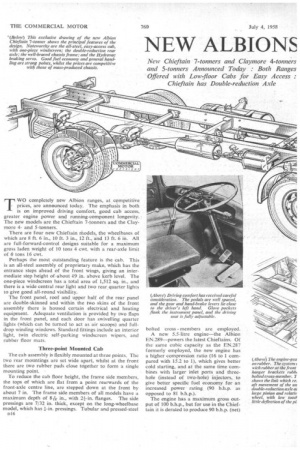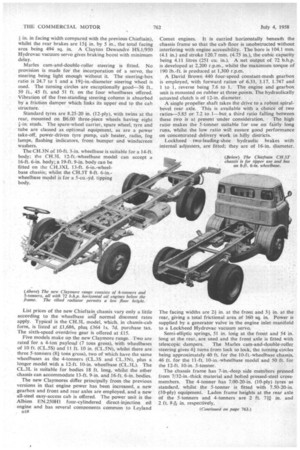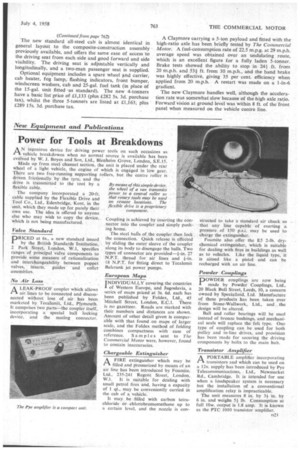NEW ALBIONS STEP AHEAD
Page 62

Page 63

Page 64

Page 67

If you've noticed an error in this article please click here to report it so we can fix it.
New Chieftain 7-tonners and Claymore 4-tonners and 5-tonners Announced Today : Both Ranges Offered with Low-floor Cabs for Easy Access : Chieftain has Double-reduction Axle
TWO completely new Albion ranges, at . competitive prices, are announced today. The emphasis in both is on improved driving comfort, good cab access, greater engine power and running-component longevity. • The new models are the Chieftain 7-tanners and the Claymore 4and 5-tanners.
There are four new Chieftain Models, the wheelbases of which are 8 ft. 6 in., 10 ft. 3 in., 12 ft., and 13 ft. 6 in. All are full-forward-control designs suitable for a maximum gross laden weight of 10 tons 4 cwt. with a rear-axle limit of 6 tons 16 cwt.
Perhaps the most outstanding feature is the cab. This is an all-steel assembly of proprietary make, which has the entrance steps ahead of the front wings, giving an intermediate step height of-about 49 in. above kerb level. The one-piece windscreen has a total area of 1,512 sq. in., and there is a wide central rear light and two rear quarter lights to give good all-round visibility.
The front panel, roof and upper half of the rear panel are double-skinned and within the two skins of the front assembly there is housed certain electrical and heating equipment. Adequate ventilation is provided by two flaps in the front panel, and each door has swivelling quarter lights (which can be turned to act as air scoops) and fulldrop winding windows. Standard fittings include an interior light, twin electric self-parking windscreen wipers, and rubber floor mats.
Three-point Mounted Cab The cab assembly is flexibly mounted at three points. The two rear mountings are set wide apart, whilst at the front there are two rubber pads close trigether to form a single mounting point.
To reduce the cab floor height, the frame side members, the tops of which are flat from a point rearwards of the front-axle centre line, are stepped down at the front by about 7 in. The frame side members of all models have a maximum depth of 8T'T in., with 2-1--in. flanges. The side pressings are 7/32 in. thick, except on the long-wheelbase model, which has 1-in. pressings. Tubular and pressed-steel
bolted cross members are employed.
A new 5.5-litre engine—the Albion EN.289—powers the latest Chieftains. Of the same cubic capacity as the EN.287 formerly employed, the new engine has a higher compression ratio (16 to 1 compared with 15.2 to 1), which gives better cold starting, and at the same time combines with larger inlet ports and threehole (instead of two-hole) injectors, to give better specific fuel economy for an increased power. rating (90 b.h.p. as opposed to 81 b.h.p.).
The engine has a maximum gross output of 100 b.h.p., but for use in the Chieftain it is derated to produce 90 b.h.p. (net) at 2,200 r.p.m., the torque output being 252 lb.-ft. at 1,250 r.p.m. This means that the engine is always working well within its designed capacity, ensuring longevity and maximum fuel economy. A 13-in.-diameter hydraulically actuated clutch is used.
Other detail engine modifications include the use of a vacuum governor on the fuel-injection pump, thereby avoiding the maintenance previously necessary with the mechanical governor, and an exhauster for braking power, ,instead of a vacuum generating valve in the inlet manifold.
An Albion five-speed constant-mesh gearbox with helical gears on third and fourth ratios is standard in the Chieftain. Top gear is direct, the other forward ratios being 6.988, 4.308, 2.655 and 1.605 to 1, with a 6.343 to 1 reverse.
Optional Sixth Speed
An overdrive sixth speed is offered, having a ratio of 0.76 to 1. It can be supplied as initial equipment at extra charge, or can be incorporated in the five-speed gearbox later simply by removing spacers on the gear shafts. The gear lever is cranked to bring it close to the driver.
The engine-gearbox unit has newly developed mountings embodying two rubber pads in compression and shear at the front of the crankcase and two rubber-hushed hanger brackets at the rear of the gearbox, with a rubber-bushed link to provide longitudinal location, The effect is to give a smooth mounting, A completely new Albion double-reduction rear axle ts installed in the Chke.ain, whereas worm drive was formerly employed. The use of a double-reduction unit has been found to be less costly than the worm axle. Moreover, as it is more robust than a conventional singlereduction unit and because of the reduced bevel-gear and half-shaft torque loadings, greater life can be expected.
Epicyclic gearing of 4 to 1 ratio is employed in the hubs. Various axle ratios are offered, and are changed by varying the reduction at the bevel gears, the standard overall ratio being 6.25 to I. As the crown wheel can be relatively small and the pinion fairly large, there is less fear of failure of the bevel gear than with the conventional single-reduction unit." Furthermore, the pinion can be carried in big taper-roller bearings without a nose bearing, and there is negligible deflection under load.
The three sets of gears have a common lubrication system, as the oil in the centre pot lubricates the hub gears also. Synthetic rubber seals are employed at the hubs. The hubs themselves are not bulky, and conventional 20-in, eight-stud wheels can be employed.
The Albion front axle is new. The king-pins are carried in plain bushes at top and bottom, vertical thrust being taken by totally enclosed steel-phosphor-bronze thrust hearings. Single-rate semi-elliptic springs are employed at front and rear and both sets are 54 in. long. The front springs are 3 in. wide, whilst those at the rear are 31 in. wide. Armstrong telescopic dampers are fitted as standard on the front axle.
Girling two-leading-shoe hydraulic brakes are installed. The front brakes measure 16 in. by 3 in. (an increase of in. in facing width compared with the previous Chieftain), whilst the rear brakes are 151 in. by 5 in., the total facing area being 494 sq. in. A Clayton Dewandre HS.1/950 Hydrovac vacuum servo gives braking boost with minimum delay.
Marles cam-and-double-roller steering is fitted. No provision is made for the incorporation of a servo, the steering being light enough without it. The steering-box ratio is 24.7 to 1 and a 191-in.-diameter steering wheel is used. The turning circles are exceptionally good-36 ft., 39 ft., 45 ft. and 51 ft. on the four wheelbases offered. Vibration of the free-standing steering column is absorbed by a friction damper which links its upper end to the cab structure.
Standard tyres are 8.25-20 in. (12-ply), with twins at the rear, mounted on B6.00 three-piece wheels having eight fin. studs. The spare-wheel carrier, spare wheel, tyre and tube are classed as optional equipment, as are a power take-off, power-driven tyre pump, cab heater, radio, fog lamps, flashing indicators, front bumper and windscreen washers.
The CH.3N of 10-ft. 3-in, wheelbase is suitable for a 14-ft. body; the CH.3L 12-ft.-wheelbase model can accept a 16-ft. 6-in, body; a 19-ft, 9-in, body can be fitted on the CH.3XL 13-ft. 6-in.-wheelbase chassis; whilst the CI-1.3T 8-ft. 6-in.wheelbase model is for a 5-cu.-Yd. tipping body.
List prices of the new Chieftain chassis vary only a little according to the wheelbase an normal discount rates apply. Typical is the CH.3L model, which, in chassis-cab form, is listed at £1,686, plus £364 is. 7d. purchase tax. The sixth-speed overdrive gear is offered at £15.
Five models make up the new Claymore range. •Two are rated for a 4-ton payload (7 tons gross), with wheelbases of 10 ft. (CL.5S) and 11 ft. 10 in. (CL.5N), whilst there are three 5-tonners (81 tons gross), two of which have the same wheelbases as the 4-tonners (CL.3S and CL.3N), plus a longer model with a 12-ft. 10-in. wheelbase (CL.3L). The CL.3L is suitable for bodies 18 ft. long, whilst the other chassis can accommodate 13-ft. 9-in. and 16-ft. 6-in. bodies.
The new Claymores differ principally from the previous versions in that engine power has been increased, a new gearbox and front and rear axles are employed, and a new all-steel easy-access cab is offered. The power unit is the Albion EN.250H1 four-cylindered direct-injection oil engine and has several components common to Leyland Comet engines. It is carried horizontally beneath the chassis frame so that the cab floor is unobstructed without interfering with engine accessibility. The bore is 104.1 mm. (4.1 in.) and stroke 120.7 mm. (4.75 in.), the cubic capacity being 4.11 litres (251 cu. in.). A net output of 72 b.h.p. is developed at 2,200 r.p.m., whilst the maximum torque of 190 lb.-ft. is produced at 1,300 r.p.m.
A David Brown 440 four-speed constant-mesh gearbox is employed, with forward ratios of 6.33, 3.17, 1.747 and 1 to 1, reverse being 7.6 to 1. The engine and gearbox unit is mounted on rubber at three points. The hydraulically actuated clutch is of 12-in. diameter.
A single propeller shaft takes the drive to a robust spiralbevel rear axle. This is available with a choice of two ratios-5.85 or 7.2 to 1-but. a third ratio falling between
these two is at present under consideration. The high ratio makes the 5-tonner suitable for use on fairly long runs, whilst the low ratio will ensure good performance on concentrated delivery work in hilly districts.
Lockheed two-leading-shoe hydraulic brakes with internal adjusters, are fitted; they are of 16-in. diameter.
The facing widths are 24in. at the front and 3+ in. at the rear, giving a total frictional area of 360 sq. in. Power is supplied by a generator valve in the engine inlet manifold to a Lockheed Hydrovac vacuum servo.
Semi-elliptic springs, 51 in. long at the front and 54 in. long at the rear, are used and the front axle is fitted with telescopic dampers. The Manes cam-and-double-roller steering gives 4+ turns from lock to lock, the turning circles being approximately 40 ft. for the 10-ft.-wheelbase chassis, 46 ft. for the 11-ft. 10-in.-wheelbase model and 50 ft. for the 12-ft 10-in. 5-tonner.
The chassis frame has 7-in.-deep side members pressed from 7/32-in.-thick material and bolted pressed-steel crossmembers. The 4-tonner has 7.00-20-in. (10-ply) tyres as standard, whilst the 5-tonner is fitted with 7.50-20-in. (10-ply) equipment. Laden frame heights at the rear axle of the 5-tonners arid 4-tonners are 2 ft. 7n in. and 2 ft. 8* in. respectively. The new standard all-steel cab is almost identical in general layout to the composite-construction assembly previously available, and offers the same ease of access -to the driving seat from each side and good forward and side visibility. The driving seat is adjustable vertically and longitudinally, -and a two-man passenger seat is supplied.
Optional equipment includes a spare wheel and carrier, cab heater, fog lamp,. flashing indicators, front bumper, windscreen washers, cab and 25-gal, fuel tank (in place of the 15-gal. unit fitted -as standard). The new 4-tonners have a basic list price of £1,133 (plus £282 5s. 3d. purchase tax), whilst the three 5-tonners are listed at £1,163, plus £289 15s. 3d. purchase tax. A Claymore carrying a 5-ton payload and fitted with the high-ratio axle has been briefly tested by The Commercial Motor. A fuel-consumption rate of 22.5 m.p.g. at 29 m.p.h. average speed was obtained over an undulating route, which is an excellent figure for a fully laden 5-tormer. Brake tests showed the ability to stop in 244 ft. from 20 m.p.h. and 531 ft. from 30 m.p.h., and the hand brake was highly effective, giving 35 per cent. efficiency when applied from 20 m.p.h. A restart was made on a 1-in-6 gradient.
The new Claymore handles well, although the acceleration rate was somewhat slow because of the high axle ratio. Forward vision at ground level was within 8 ft. of the front panel when measured on the vehicle centre line.




























































































































